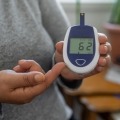Omnipod 5 Trial Results Show Increased Time in Range for Adults and Youth with Diabetes
By Eliza Skoler
.png) By Eliza Skoler and Albert Cai
By Eliza Skoler and Albert Cai
Insulet’s Omnipod 5 automated insulin delivery system was shown to be effective, safe, and easy to use for adults, teens, and children with type 1 diabetes. Early results from a very small group also show Omnipod 5 to be particularly helpful for people with type 2 diabetes.
Insulet shared results from the clinical trial of its new Omnipod 5 automated insulin delivery (AID) system. AID systems combine continuous glucose monitors (CGM) and smart algorithms to automatically adjust insulin delivery via an insulin pump. The Omnipod 5 system was tested in adults, adolescents, and children with type 1 diabetes to evaluate its effectiveness and safety. Across both studies, Omnipod 5 was found to be safe and easy to use, and led to improvements in A1C and Time in Range (TIR).
What’s Omnipod 5?
The Omnipod 5 system is the first tubeless, patch-based AID system; it will also be the first AID system with full smartphone control. The system includes Insulet’s disposable Omnipod insulin patch pump, Dexcom’s G6 CGM, and the Omnipod 5 algorithm (built into the patch pump). Users who have Android smartphones will be able to access their data and control their insulin delivery via the Omnipod 5 app. For now, those with iOS devices will use a system controller until the iPhone version of the app is developed and cleared by the FDA.
Other notable features of Omnipod 5 include:
-
Adjustable glucose targets between 110 to 150 mg/dl, which can be adjusted by time of day.
-
A HypoProtect feature allows users to temporarily set their glucose target at 150 mg/dl and restricts insulin delivery to prevent low blood sugar (hypoglycemia). This is especially helpful during exercise.
-
A built-in smart bolus calculator that is informed by glucose values and trends.
-
Direct communication between the pump’s algorithm and the Dexcom G6 means the system will work even without the smartphone or pump controller nearby.
The only AID systems currently available in the US are Tandem’s Control-IQ and Medtronic’s MiniMed 670G and 770G. Omnipod will be the first system that uses a patch pump. To learn more about advances in AID technology, read “Tech on the Horizon: Where Will Automated Insulin Delivery (AID) be in 2021?”
What did the trials show?
The clinical trial enrolled 241 participants with type 1 diabetes (129 adolescents and adults and 112 children) in the US. For the first two weeks of the trial, participants wore a Dexcom G6 CGM and followed their usual insulin regimen to capture baseline data; they then used the Omnipod 5 system for three months. After three months of Omnipod 5 use, Time in Range increased, time in hyperglycemia and hypoglycemia decreased, and average A1C decreased. You can view the data in a chart below.
-
Time in Range:
-
TIR in adults and adolescents increased from 65% to 74%, or more than two hours per day.
-
TIR in children increased from 52% to 68%, or more than three and a half hours per day.
-
-
Hyperglycemia:
-
Time Above Range (TAR, or glucose levels greater than 180 mg/dl) decreased from 32% to 25% in the adult trial.
-
TAR decreased from 45% to 30% in the child trial – a difference of about three and a half hours per day.
-
-
Hypoglycemia:
-
Time Below Range (TBR, glucose levels below 70 mg/dl) fell from 2.0% to 1.1% in the adult trial.
-
Omnipod 5 did not decrease TBR in children, which was already low (1.4%) at baseline.
-
-
Average A1C:
-
In adults and adolescents, A1C fell from 7.2% to 6.8%. By the end of the study, two-thirds of participants had A1Cs below 7% – the American Diabetes Association’s target for people with diabetes.
-
In children, A1C fell from 7.7% to 7%. By the end of study, over half (53%) of participants had an A1C below 7% (compared to just 23% at baseline).
-
-
Most participants will continue: 92% of adults and adolescents, and 99% of children, opted to continue using Omnipod 5 in the one-year extension phase of the trial.
|
|
Adolescents and adults |
Children |
||
|
Study sample |
128 people with type 1, ages 14-70 |
113 people with type 1, ages 6-13 |
||
|
|
Baseline |
Study |
Baseline |
Study |
|
Time in Range |
65% |
74% |
52% |
68% |
|
A1C |
7.2% |
6.8% |
7.7% |
7% |
|
Time Above Range (glucose greater than 180 mg/dl) |
32% |
25% |
45% |
30% |
|
Time above 250 mg/dl |
10% |
6% |
19% |
10% |
|
Time Below Range (glucose lower than 70 mg/dl) |
2% |
1.1% |
1.4% |
1.5% |
|
Time below 54 mg/dl |
0.2% |
0.2% |
0.1% |
0.2% |
The clinical trial is also testing Omnipod 5 in adults with type 2 diabetes, to see if the system is as effective among those with type 2. Results from the first four participants in the trial were shared, showing positive effects. After just eight weeks using Omnipod 5, the group’s TIR more than doubled (27% at baseline to 59%, a difference of almost eight hours per day) and time with glucose levels above 250 mg/dl dropped dramatically (from 40% at baseline to 11%).
We’re looking forward to full results from the trial. The small study eventually aims to enroll 24 participants with type 2 diabetes and an A1C between 8% and 12%. The participants will wear Dexcom G6 for the first two weeks on standard therapy (either MDI basal-bolus or basal-only insulin therapy), before using Omnipod 5 for eight weeks. Participants will continue taking any previous glucose-lowering drugs.
Across the groups the new results are encouraging. Omnipod 5 has been submitted to the FDA and will hopefully receive clearance soon; Insulet is aiming to start a limited launch of the product in the first half of 2021, with broader release later in the year.








